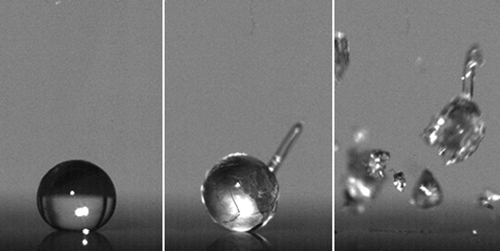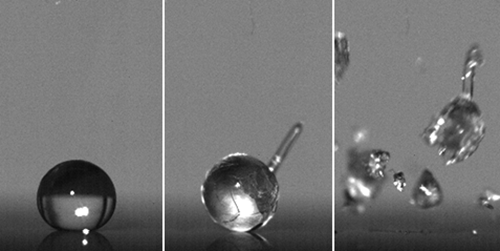Drops Shatter in the Cold
Droplets of water can burst apart when they freeze, sending out shards of ice in all directions. Sander Wildeman at the University of Twente in the Netherlands and colleagues have now filmed this process in unprecedented detail—from the formation of the first ice crystal to the final bang. This footage, plus the groups’ model-based calculations, reveals when and why water drops rupture as they freeze from the outside in.
The team began by supercooling a roughly millimeter-sized water drop in a specially designed chamber. This step puts the droplet at a temperature below its freezing point but leaves it free of ice crystals, thus ensuring the same starting conditions for all experiments. The researchers then set the freezing process in motion by touching the drop with a tip.
The team’s high-speed videos reveal that the freezing process in drops is complex. Within a few microseconds of being touched, a “shell” of solid ice encapsulates the drop and starts to thicken inwards, compressing still-liquid water. Some of the building pressure is released by an “arm” of ice that extends from one side of the drop. But eventually, cracks and bubbles form, and within about two seconds of the process beginning, the droplet shatters. Turning to their model, the group predicts that drops with diameters larger than 50 m will always explode when frozen because of their high inner pressures. Smaller drops, however, never burst because the surface tension of the shell is strong enough to keep them intact. The size dependence might influence the formation of hailstones and other precipitation.
This research is published in Physical Review Letters.
–Katherine Wright
Katherine Wright is a Contributing Editor for Physics.





